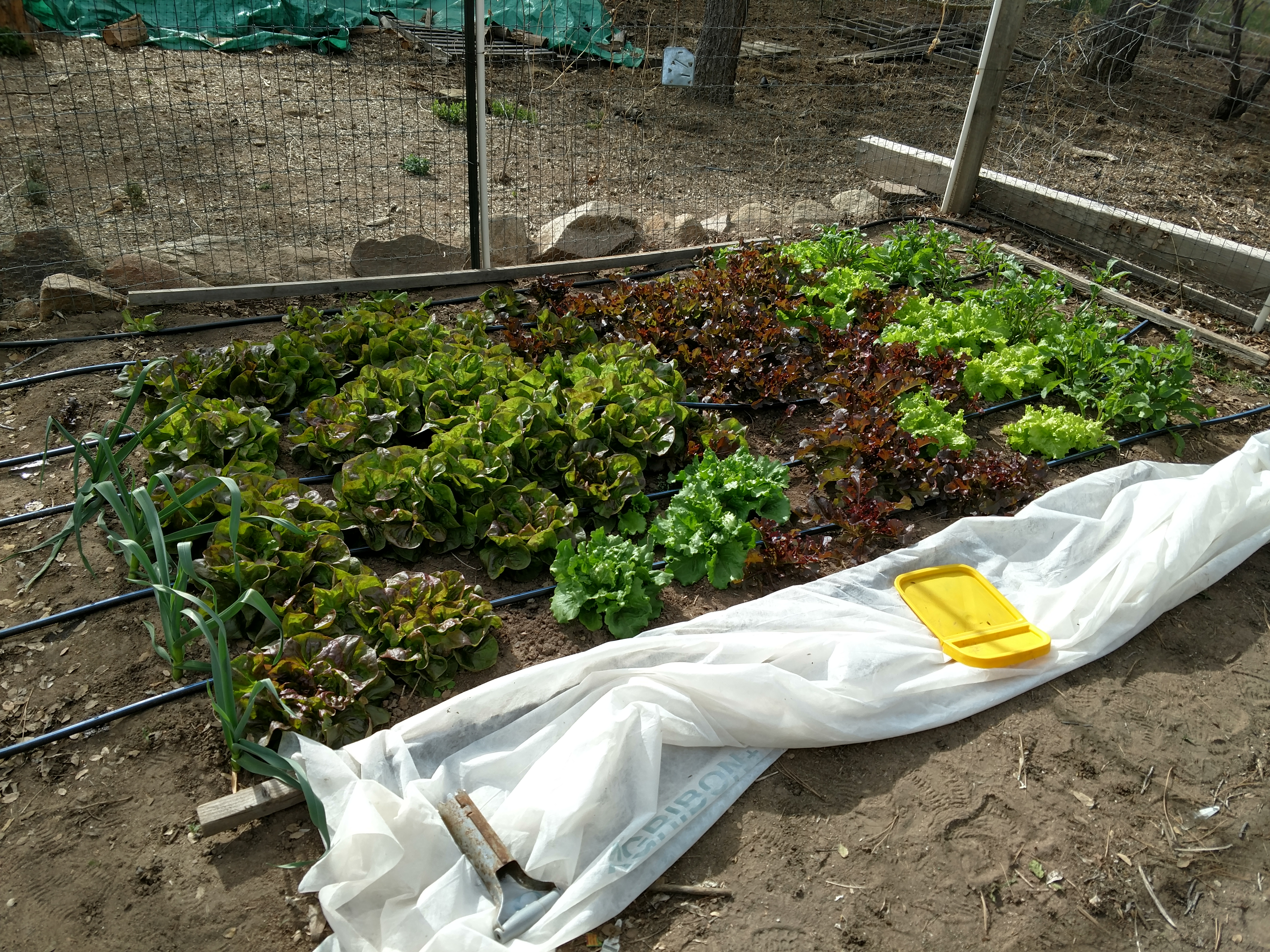 Growing Lettuce - September 5, 2017 Jeff Schalau, Agent, Agriculture & Natural Resources University of Arizona Cooperative Extension, Yavapai County Lettuce was first cultivated in Egypt for the oil contained in its seeds and was then bred to have edible leaves. The leafy vegetable then spread to Greece, Rome and later throughout Europe. Today we grow lettuce as a cool-season crop. It prefers sunny locations with fertile, well-drained soils. Lettuce can easily be grown fall through spring in north central Arizona at elevations below 6,000 feet. Winter grown lettuce does best when season extension techniques (floating row cover, low tunnels, etc.) are used. It can also be grown during summer if heat-tolerant varieties are selected. Lettuces are usually grouped into three types: head lettuces (Iceberg and Butterhead types); Romaine or Cos types, and leaf lettuces. In my opinion, home gardeners will have the greatest success growing leaf lettuces. Leaf lettuce varieties have loosely formed heads with green, red, purple leaves. Many varieties can have a combination of these colors. There are many varieties of leaf lettuce and gardeners should experiment with these. I’ve had good experiences with the following varieties ‘Red Salad Bowl’, ‘Yugoslavian Red’, ‘Oak Leaf’, and ‘Tropicana’. Heat tolerant varieties leaf lettuce varieties for summer planting include ‘Simpson Black Seed’, ‘Simpson Elite’, and ‘Slobolt’. To prepare soil for lettuce crops, incorporate 2-4 inches of well composted organic matter into the top six inches of soil. Alfalfa cubes can also be used rather than compost. Alfalfa cubes should be wetted and “expanded” before incorporation. See the March 29, 2017 online edition of the Backyard Gardener for more soil preparation information. An application of phosphorus fertilizer (rock phosphate, bone meal, or triple super phosphate) can also be incorporated. After incorporating amendments, rake the soil surface to smooth, apply water to settle, allow to dry for a day or so, then rake smooth again and sow seed. Lettuce can be grown from transplants, but I prefer direct seeding. Lettuce seeds should be sown no deeper than ¼ to ½ inch deep. I sow the seeds on the soil surface and lightly rake in to achieve the proper depth. When temperatures are warm (between 50 and 75 degrees F), lettuce plants can mature in 50 to 75 days. During cold weather, growth is slower. Young lettuce plants can tolerate freezing weather. Plants should be thinned to an 8 to 10 inch spacing. Thinned plants can be harvested and eaten. Similarly, individual leaves can be harvested from growing plants. Make sure to harvest the oldest leaves and not to remove more than a quarter of the leaves allowing for regrowth between harvests. Lettuce requires 1-2 inches of water per week. Drip irrigation is ideal, but may not be feasible during freezing weather. Moisture fluctuations will cause leaves to become tough and/or bitter. A light midseason fertilization can also boost growth. I use alfalfa cubes for this purpose in warmer weather. In winter lettuce plantings, I forego midseason fertilization. Weeds should be aggressively managed and crop rotation should be practiced. Pocket gophers should also be managed through trapping. Floating row covers not only provide frost protection, but also create a physical barrier to bird and rabbit herbivory. Last winter, I grew one of the best lettuce patches I’ve ever had. I prepared the soil with alfalfa cubes and triple super phosphate prior to planting seeds of three lettuce varieties on November 14. The patch was irrigated and covered with a light row cover (Agribon AG-19). Young plants were transplanted within the bed in January to improve spacing. Seeds germinated and grew slowly until March, but by mid-April it was going strong and it produced into mid-May. I’ve included photos of the developing and mature crop in addition to useful lettuce growing publications with the online edition (see URL below). Hopefully, this information will inspire you to grow lettuce. Nothing tastes as good as fresh picked lettuce! Naming of companies or products is neither meant to imply endorsement by the author nor criticism of similar companies or products not mentioned. Follow the Backyard Gardener on Twitter – use the link on the BYG website. If you have other gardening questions, call the Master Gardener help line in the Camp Verde office at 928-554-8992 or e-mail us at verdevalleymg@gmail.com and be sure to include your name, address and phone number. Find past Backyard Gardener columns or provide feedback at the Backyard Gardener web site: http://cals.arizona.edu/yavapai/anr/hort/byg/. Photos  Lettuce bed planted November 14, 2017 shown on March 25, 2018. All are leaf lettuces. From left to right, varieties are 'Yugoslavian Red', 'Red Salad Bowl', and 'Slobolt'. Arugula is growing on the right side of the lettuce bed. Floating row cover is shown to the side of the bed.
Lettuce bed planted November 14, 2017 shown on March 25, 2018. All are leaf lettuces. From left to right, varieties are 'Yugoslavian Red', 'Red Salad Bowl', and 'Slobolt'. Arugula is growing on the right side of the lettuce bed. Floating row cover is shown to the side of the bed. Lettuce bed planted November 14, 2017 shown on April 11, 2018. All are leaf lettuces. From left to right, varieties are 'Yugoslavian Red', 'Red Salad Bowl', and 'Slobolt'. Arugula is growing on the right side of the lettuce bed. Floating row cover is shown to the side of the bed.
Lettuce bed planted November 14, 2017 shown on April 11, 2018. All are leaf lettuces. From left to right, varieties are 'Yugoslavian Red', 'Red Salad Bowl', and 'Slobolt'. Arugula is growing on the right side of the lettuce bed. Floating row cover is shown to the side of the bed.Related Publications Lettuce in the Garden Utah State University Cooperative Extension digitalcommons.usu.edu/cgi/viewcontent.cgi?referer=&httpsredir=1&article=1248&context=extension_curall How to Grow Lettuce Michigan State University Extension www.canr.msu.edu/resources/how_to_grow_lettuce Home Garden Lettuce University of Georgia Extension extension.uga.edu/publications/detail.html?number=C1018&title=Home%20Garden%20Lettuce |